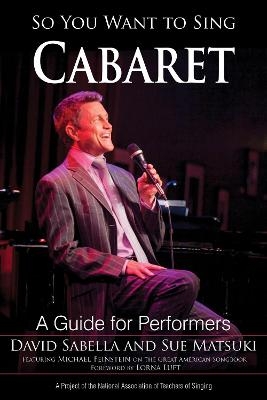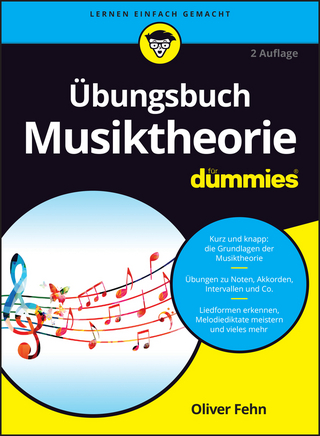
So You Want to Sing Cabaret
Rowman & Littlefield (Verlag)
978-1-5381-2404-8 (ISBN)
Cabaret performances are often known for bringing alive the Great American Songbook from the 1920s through the 1950s for contemporary audiences. But modern-day cabaret does much more than preserve the past—it also promotes and fosters the new generation of American composers and creates a uniquely vibrant musical and theatrical experience for its audiences. So You Want to Sing Cabaret is the first book of its kind to examine in detail the unique vocal and nonvocal requirements for professional performance within the exciting genre of cabaret.
With a foreword by cabaret legend Lorna Luft, So You Want to Sing Cabaret includes interviews from the top professionals in the cabaret industry, including Michael Feinstein, Ann Hampton Callaway, Roy Sander, Sidney Myer, Jeff Harner and many others. There are also chapters devoted to crafting your show, lyric connection, “do-it-yourself” production and promotion, and working with your musical team. David Sabella and Sue Matsuki have crafted the perfect one-volume resource for both the aspiring cabaret singer and the singing teacher who seeks to learn more about this unique art form.
The So You Want to Sing series is produced in partnership with the National Association of Teachers of Singing. Like all books in the series, So You Want to Sing World Music features online supplemental material on the NATS website. Please visit www.nats.org to access style-specific exercises, audio and video files, and additional resources.
David Sabella is internationally recognized as a master teacher in music theater and contemporary commercial music voice techniques. He served as a two-term president of the New York Singing Teachers’ Association (NYSTA) and as an executive director of the Broadway Theatre Project. He has also served on the music theater voice faculties at Montclair State University and Fordham University, as well as NYU’s Tisch School of the Arts, CAP21 Studio, the New School’s Mannes Prep precollege program, Purchase College, and SUNY at New Paltz. Sue Matsuki is the recipient of the first Julie Wilson Award, given by the Mabel Mercer Foundation in 2004, and was personally chosen to receive this award by Julie Wilson herself. She is also a three-time MAC Award winner: 2002 for Female Jazz/Pop/R&B Vocalist; 2006 for Jazz Duo/Special Productions for Ten Years in the Making with her music director Gregory Toroian; and 2008 for Specialty Song with “One Stop Shopping” (Matsuki/Toroian/Page).
Chapter 1 - Cabaret: Historical Background
An overview and history of the cabaret rooms of Europe in the 19th and
early 20th centuries.
Chapter 2 – Modern Day Cabaret: 20th -21st Century
Crossing the Pond – The early proponents in the U.S. (such as Mabel
Mercer) of modern day cabaret and their impact on American popular
singers of the 20th century (Frank Sinatra, Judy Garland).
•⊂ What has cabaret come to be known as in the last 40 years?
•⊂ Who are the major performers today and what makes them
“cabaret singers”?
•⊂ How does cabaret performance differ from other live vocal
performance shows?
Chapter 3 – Cabaret Training: What it is and why it is needed
Training programs – what they offer to singers and why training in the art
of cabaret performance is important.
What a singer should look for in a cabaret training program.
Chapter 4 – Cabaret and the Musical Theater Singer
The chapter addresses the training and perspective of a musical theater
performer and what parts are or are not applicable to cabaret. Examples
of Issues addressed are:
•⊂ The elimination of the “4th wall”
•⊂ Being yourself vs. Being a character
•⊂ The relationship a musical theater performer has to the audience vs.
the relationship the cabaret singer has to the audience.
So You Want to Sing Cabaret - Tim Schall, Proposal
Chapter Descriptions
•⊂ What habits (good or bad) do musical theater singers develop that
helps/hinders them transition into working in cabaret.
Chapter 5- Cabaret and the Classical Singer
The chapter addresses the training and perspective of a classically trained
“legit” singer and how that training/perspective is adapted to cabaret.
Examples of Issues include:
•⊂ Taking the focus off of your voice
•⊂ Putting the focus on the lyric
•⊂ Trusting your body
•⊂ Being “natural”
Chapter 6 – Cabaret and the Pop Singer
The chapter addresses the training and perspective of a pop singer and
how that training/perspective is adapted to cabaret. Examples include:
•⊂ Where are you creative objectives as a pop singer and where are
they as a cabaret performer?
•⊂ Riffing: To riff or not to riff? What is its purpose in pop singing and
what is it, if any, in cabaret performance?
•⊂ Making a recording vs. performing a song live
•⊂ Transitioning from a “sound machine” to a live human being with
something to share/say.
•⊂ The jazz singer: how cabaret work can help them relate more
directly to their audience and add an extra dimension to their
performances.
Chapter 7 – It’s About The Lyrics (newly added)
Cabaret is a lyric driven art form. This chapter explores why a singer
should consider the lyrics first when choosing a song. The challenges of
different genres of lyrics and how they are best adapted and used in a
cabaret setting are explored:
•⊂ Great American songbook lyricists
•⊂ Musical Theater lyricists (many times, the same as the above)
So You Want to Sing Cabaret - Tim Schall, Proposal
Chapter Descriptions
•⊂ Pop lyrics – the challenge to make these dramatically playable
Chapter 8 (newly added) – Working With Your Music Director
Note: This chapter could potentially be divided into two chapters:
1) Working with a Musical Director/Pianist and 2) Creating Arrangements.
One of the most important relationships in the singer’s development as a
cabaret performer is with their musical director/pianist. This chapter
discusses:
•⊂ The criteria you should look for in a musical director – skill sets,
willingness to collaborate, area of musically expertise.
•⊂ Communicating with the musical director/pianist in light of how
much musicianship skills and language a singer has or does not
have.
•⊂ Creating arrangements – why this is vital and how to participate in
the process even though you are may not be the musician in the
room.
Chapter 9 – Putting it Together/Creating an Act
Note: This chapter could also become two chapters, because it is loaded
with important information.
Creating an Act or Show is often a very daunting project for singers. Live
performers from pop/rock singers and nightclub singers to classical
singers in recitals have struggled with putting together cohesive
programming that flows with a beginning, middle and end. Topics
discussed include song choices, song types and song order. We explore
the purpose of an opening number, the purpose of a closing number, the
11 O’clock number, the encore and different types of ballads.
Patter, or stage dialogue, is also explored. Patter is a craft in and of itself
and can often either be too stiff or too sloppy. It has tremendous impact
on the show, yet should seem as if it is spontaneous and natural – but
So You Want to Sing Cabaret - Tim Schall, Proposal
Chapter Descriptions
should be planned out.
Working with a director is explored. What is a director’s role in the
creation and performance of a cabaret show? What service does the
director provide for the singer?
Chapter 10 – Cabaret As A Means In Itself
Cabaret performance is a specific art from in itself. Many singers choose
to focus their performance work solely in this area. This chapter discusses
the path of the singer focusing on cabaret:
•⊂ U.S. cities that have cabaret communities.
•⊂ What expectations can be met career-wise and artistically.
•⊂ When is this the right choice for a singer.
•⊂ How to market yourself
•⊂ Working in clubs – agreements, light/sound, promotions
•⊂ Recording content, demos, websites and self marketing.
Chapter 11– Cabaret Training As A Tool
Cabaret is also occasionally taught in university musical theater training
program. This chapter explores how the personalization of material can
help musical theater performers, non-singing actors and classical singers
in their performing and auditioning – whether they choose to pursue
cabaret work or not.
Chapter 12 - Closing Thoughts
•⊂ An overview of the national cabaret landscape. Specific cities and
what is their cabaret scene like?
•⊂ Advocating for the art form. Why does it need preserving and how
to preserve it.
•⊂ Educating and informing future generations.
| Erscheinungsdatum | 10.05.2021 |
|---|---|
| Reihe/Serie | So You Want to Sing |
| Co-Autor | Michael Feinstein |
| Vorwort | Lorna Luft |
| Verlagsort | Lanham, MD |
| Sprache | englisch |
| Maße | 153 x 221 mm |
| Gewicht | 735 g |
| Themenwelt | Kunst / Musik / Theater ► Musik |
| ISBN-10 | 1-5381-2404-1 / 1538124041 |
| ISBN-13 | 978-1-5381-2404-8 / 9781538124048 |
| Zustand | Neuware |
| Haben Sie eine Frage zum Produkt? |
aus dem Bereich


